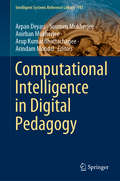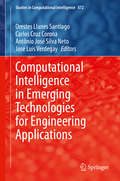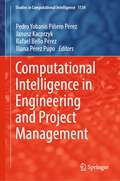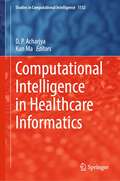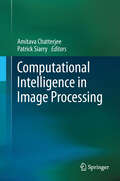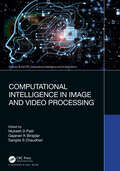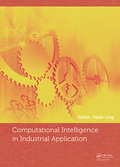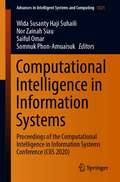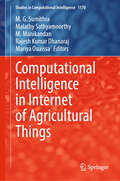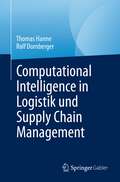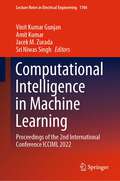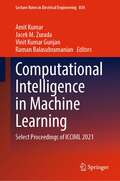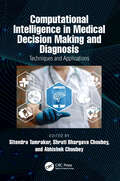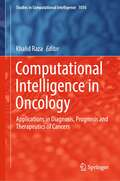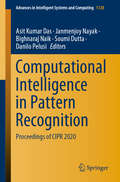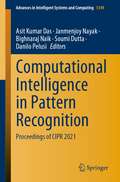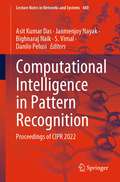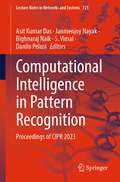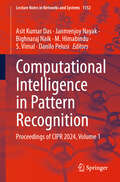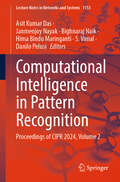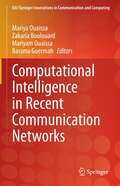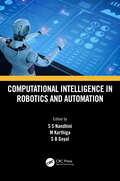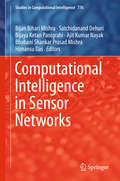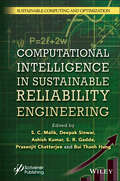- Table View
- List View
Computational Intelligence in Digital Pedagogy (Intelligent Systems Reference Library #197)
by Anirban Mukherjee Arpan Deyasi Soumen Mukherjee Arup Kumar Bhattacharjee Arindam MondalThis book is a useful guide for the teaching fraternity, administrators and education technology professionals to make good use of AI across outcome-based technical education (OBTE) ecosystem and infuse innovations and affordable digital technologies to traditional pedagogic processes to make teaching-learning more independent of human factor (teacher/student quality), time and place and at the same time more impactful and enjoyable for the learners. Providing access to the digital media and learning tools (even to the extent of mobile apps) to the students would allow them to keep pace with innovations in learning technologies, learn according to their own pace and improve their understanding level and have instantaneous feedback and evaluation. The book explores these new challenges and scope of using computational intelligence in educational technology. The book also addresses how based on the data collected from the outcome of conventional educational system, intelligent diagnostic and feedback system is developed which will change the teaching strategies and corresponding teaching-learning process. The book covers a wider framework of digital pedagogy and its intelligent applications on various sectors of education system.
Computational Intelligence in Emerging Technologies for Engineering Applications (Studies in Computational Intelligence #872)
by Orestes Llanes Santiago José Luis Verdegay Carlos Cruz Corona Antônio José Silva NetoThis book explores applications of computational intelligence in key and emerging fields of engineering, especially with regard to condition monitoring and fault diagnosis, inverse problems, decision support systems and optimization. These applications can be beneficial in a broad range of contexts, including: water distribution networks, manufacturing systems, production and storage of electrical energy, heat transfer, acoustic levitation, uncertainty and robustness of infinite-dimensional objects, fatigue failure prediction, autonomous navigation, nanotechnology, and the analysis of technological development indexes. All applications, mathematical and computational tools, and original results are presented using rigorous mathematical procedures. Further, the book gathers contributions by respected experts from 22 different research centers and eight countries: Brazil, Cuba, France, Hungary, India, Japan, Romania and Spain. The book is intended for use in graduate courses on applied computation, applied mathematics, and engineering, where tools like computational intelligence and numerical methods are applied to the solution of real-world problems in emerging areas of engineering.
Computational Intelligence in Engineering and Project Management (Studies in Computational Intelligence #1134)
by Janusz Kacprzyk Rafael Bello Pérez Pedro Yobanis Piñero Pérez Iliana Pérez PupoThis book is dedicated to all those interested in the application of artificial intelligence in engineering and project management. Most of the jobs are focused on achieving agile project development. New algorithms that combine various computational intelligence techniques are applied in different areas of knowledge in project management.In this book, computational intelligence is presented as the branch of AI that encompasses various techniques aimed at simulating human tolerance in decision-making processes in environments with uncertainty and imprecision. Among the precursor techniques of computational intelligence are: evolutionary algorithms, artificial neural networks, fuzzy set theory, and fuzzy systems. However, other areas such as the rough set, linguistic data summary, natural language processing, the conversational systems, fuzzy cognitive maps, collective intelligence, the neutrosophic theory, and other fuzzy logic extensions are contributing to the application and extension of computational intelligenceThe book is organized into three parts, as shown below. The first part constitutes a critical review of computational intelligence in project management. The second part presents new computational intelligence techniques and their applications in project planning, control, and monitoring processes. In particular, the use of conversational systems and their applicability in the agile management of portfolio programs and projects stand out. Part three of the book exemplifies the use of computing techniques with words and other computational intelligence techniques for organizational decision-making.The authors of the book stand out for their extensive experience in the development of basic and applied applications of computational intelligence. The authors Janusz Kacprzyk, Pedro Y. Piñero Pérez, Rafael E. Bello Pérez, and Iliana Pérez Pupo have published several books associated with artificial intelligence and computational intelligence applied to projects. They continue working on fundamental-oriented and applied research on different artificial intelligence techniques to help with decision-making in different areas of knowledge.Authors would like to thank all the engineers, professors, and researchers without whose efforts this book could not have been written.
Computational Intelligence in Healthcare Informatics (Studies in Computational Intelligence #1132)
by Kun Ma D. P. AcharjyaThe book presents advancements in computational intelligence in perception with healthcare applications. Besides, the concepts, theory, and applications in various domains of healthcare systems including decision making in healthcare management, disease diagnosis, and electronic health records will be presented in a lucid manner. To achieve these objectives, both theoretical advances and its applications to healthcare problems will be stressed upon. This has been done to make the edited book more flexible and to stimulate further research interest in topics. The book is divided into four sections such as theoretical foundation of computational intelligence techniques, computational intelligence in analyzing health data, computational intelligence in electronic health record (EHR), and computational intelligence in ethical issues in health care.
Computational Intelligence in Image Processing
by Patrick Siarry Amitava ChatterjeeComputational intelligence based techniques have firmly established themselves as viable, alternate, mathematical tools for more than a decade. They have been extensively employed in many systems and application domains, among these signal processing, automatic control, industrial and consumer electronics, robotics, finance, manufacturing systems, electric power systems, and power electronics. Image processing is also an extremely potent area which has attracted the attention of many researchers who are interested in the development of new computational intelligence-based techniques and their suitable applications, in both research problems and in real-world problems. Part I of the book discusses several image preprocessing algorithms; Part II broadly covers image compression algorithms; Part III demonstrates how computational intelligence-based techniques can be effectively utilized for image analysis purposes; and Part IV shows how pattern recognition, classification and clustering-based techniques can be developed for the purpose of image inferencing. The book offers a unified view of the modern computational intelligence techniques required to solve real-world problems and it is suitable as a reference for engineers, researchers and graduate students.
Computational Intelligence in Image and Video Processing (Chapman & Hall/CRC Computational Intelligence and Its Applications)
by Mukesh D Patil Gajanan K Birajdar Sangita S ChaudhariComputational Intelligence in Image and Video Processing presents introduction, state-of-the-art and adaptations of computational intelligence techniques and their usefulness in image and video enhancement, classification, retrieval, forensics and captioning. It covers an amalgamation of such techniques in diverse applications of image and video processing. Features: A systematic overview of state-of-the-art technology in computational intelligence techniques for image and video processing Advanced evolutionary and nature-inspired approaches to solve optimization problems in the image and video processing domain Outcomes of recent research and some pointers to future advancements in image and video processing and intelligent solutions using computational intelligence techniques Code snippets of the computational intelligence algorithm/techniques used in image and video processing This book is primarily aimed at advanced undergraduates, graduates and researchers in computer science and information technology. Engineers and industry professionals will also find this book useful.
Computational Intelligence in Industrial Application: Proceedings of the 2014 Pacific-Asia Workshop on Computer Science in Industrial Application (CIIA 2014), Singapore, December 8-9, 2014
by Yanlv LingThese proceedings of the 2014 Pacific-Asia Workshop on Computational Intelligence in Industrial Application (CIIA 2014) include 81 peer-reviewed papers. The topics covered in the book include: (1) Computer Intelligence, (2) Application of Computer Science and Communication, (3) Industrial Engineering, Product Design and Manufacturing, (4) Automatio
Computational Intelligence in Information Systems: Proceedings of the Computational Intelligence in Information Systems Conference (CIIS 2020) (Advances in Intelligent Systems and Computing #1321)
by Saiful Omar Wida Susanty Haji Suhaili Nor Zainah Siau Somnuk Phon-AmuaisukThis book constitutes the Proceeding of the Computational Intelligence in Information Systems conference (CIIS 2020), held in Brunei, January 25–27, 2021. The CIIS conference provides a platform for researchers to exchange the latest ideas and to present new research advances in general areas related to computational intelligence and its applications. The 23 revised papers presented in this book have been carefully selected from 55 submissions.
Computational Intelligence in Internet of Agricultural Things (Studies in Computational Intelligence #1170)
by Mariya Ouaissa M. G. Sumithra Rajesh Kumar Dhanaraj Malathy Sathyamoorthy M. ManikandanThis book focuses on the integration of IoT and AI techniques to generate greater data-driven solutions for the agriculture industry. It also focuses on computational intelligence (CI), machine learning, and AI techniques along with current applications, obstacles, and potential challenges and solutions for agricultural industries. These technologies have the potential to curtail resource wastage and contribute to addressing the challenges of feeding the expanding global population. This book acts as a resource to augment the reader's comprehension of the role of emerging IT technologies in the agricultural sector. This book also covers key technologies and techniques such as AI, ML, and IoT in the development of smart agriculture and provides information on various types of smart farming technology, platforms, and machine learning algorithms with case studies based on real-time problems.
Computational Intelligence in Logistik und Supply Chain Management
by Thomas Hanne Rolf DornbergerDas Buch zeigt komplexe Probleme in den Bereichen Logistik und Supply Chain Management und erörtert fortschrittliche Methoden, insbesondere aus dem Bereich Computational Intelligence (CI), zu deren Lösung. Die ersten beiden Kapitel bieten allgemeine Einführungen in die Logistik, das Lieferkettenmanagement und in die Computational Intelligence. Die folgenden Kapitel behandeln spezifische Bereiche der Logistik und des Supply Chain Managements und diskutieren Lösungsansätze. In Kapitel 3 werden Probleme der Transportplanung, wie z. B. Arten von Vehicle Routing, betrachtet. In Kapitel 4 werden Probleme aus dem Bereich der Produktions- und Lagerverwaltung erörtert. Kapitel 5 befasst sich mit Planungsaktivitäten beim Scheduling. Während in den Kapiteln 3 bis 5 eher Planungsprobleme auf operativer Ebene behandelt werden, geht es in Kapitel 6 um das strategische Problem der Gestaltung einer Lieferkette oder eines Netzwerks. Das letzte Kapitel gibt einen Überblick über akademische und kommerzielle Software und Informationssysteme für die diskutierten Anwendungen.Es scheint eine Lücke zu geben zwischen allgemeinen Lehrbüchern über Logistik und Supply Chain Management und speziellerer Literatur, die sich mit Methoden der Computational Intelligence, des Operations Research usw. zur Lösung komplexer betrieblicher Probleme in diesen Bereichen befasst. Für den Leser ist es oft schwierig, von einführenden Texten über Logistik und Supply Chain Management zu der anspruchsvollen Literatur über die Anwendung fortgeschrittener Methoden überzugehen. Dieses Buch füllt diese Lücke, indem es Beschreibungen der entsprechenden Probleme und geeignete Methoden zu ihrer Lösung auf dem neuesten Stand der Technik bereitstellt.Dieses Buch ist eine Übersetzung einer deutschen Originalausgabe. Die Übersetzung wurde mit Hilfe von künstlicher Intelligenz (maschinelle Übersetzung durch den Dienst DeepL.com) erstellt. Eine anschließende menschliche Überarbeitung erfolgte vor allem in Bezug auf den Inhalt, so dass sich das Buch stilistisch anders liest als eine herkömmliche Übersetzung.
Computational Intelligence in Machine Learning: Proceedings of the 2nd International Conference ICCIML 2022 (Lecture Notes in Electrical Engineering #1106)
by Amit Kumar Vinit Kumar Gunjan Jacek M. Zurada Sri Niwas SinghThis volumes comprises select proceedings of the International Conference on Computational Intelligence in Machine Learning (ICCIML 2022). The contents cover latest research trends and developments in the areas of machine learning, smart cities, IoT, Artificial Intelligence, cyber physical systems, cybernetics, data science, neural network, cognition, among others. It also addresses the comprehensive nature of computational intelligence, AI, ML and DL to emphasize its character in modelling, identification, optimization, prediction, forecasting, and control of future intelligent systems. This volume will be a useful guide to those working as researchers in academia and industry by presenting in-depth fundamental research contributions from a methodological/application perspective in understanding Artificial intelligence and machine learning approaches and their capabilities in solving diverse range of problems in industries and its real-world applications.
Computational Intelligence in Machine Learning: Select Proceedings of ICCIML 2021 (Lecture Notes in Electrical Engineering #834)
by Amit Kumar Vinit Kumar Gunjan Jacek M. Zurada Raman BalasubramanianThe book includes select proceedings of the International Conference on Computational Intelligence in Machine Learning (ICCIML 2021). The book constitutes peer-reviewed papers on machine learning, computational intelligence, the internet of things, and smart city applications emphasizing multi-disciplinary research in artificial intelligence and cyber-physical systems. This book addresses the comprehensive nature of computational intelligence, artificial intelligence, machine learning, and deep learning to emphasize its character in modeling, identification, optimization, prediction, forecasting, and control of future intelligent systems. The book will be useful for researchers, research scholars, and students to formulate their research ideas and find future directions in these areas. It will help the readers to solve a diverse range of problems in industries and their real-world applications.
Computational Intelligence in Medical Decision Making and Diagnosis: Techniques and Applications (Computational Intelligence Techniques)
by Sitendra Tamrakar Shruti Bhargava Choubey Abhishek ChoubeyComputation intelligence (CI) paradigms, including artificial neural networks, fuzzy systems, evolutionary computing techniques, and intelligent agents, form the basis of making clinical decisions. This book explains different aspects of the current research on CI technologies applied in the field of medical diagnosis. It discusses critical issues related to medical diagnosis, like uncertainties in the medical domain, problems in the medical data, especially dealing with time-stamped data, and knowledge acquisition. Features: Introduces recent applications of new computational intelligence technologies focusing on medical diagnosis issues. Reviews multidisciplinary research in health care, like data mining, medical imaging, pattern recognition, and so forth. Explores intelligent systems and applications of learning in health-care challenges, along with the representation and reasoning of clinical uncertainty. Addresses problems resulting from automated data collection in modern hospitals, with possible solutions to support medical decision-making systems. Discusses current and emerging intelligent systems with respect to evolutionary computation and its applications in the medical domain. This book is aimed at researchers, professionals, and graduate students in computational intelligence, signal processing, imaging, artificial intelligence, and data analytics.
Computational Intelligence in Medical Imaging: Techniques and Applications
by Gerald Schaefer Aboul Ella Hassanien Jianmin JiangCI Techniques & Algorithms for a Variety of Medical Imaging SituationsDocuments recent advances and stimulates further researchA compilation of the latest trends in the field, Computational Intelligence in Medical Imaging: Techniques and Applications explores how intelligent computing can bring enormous benefit to existing technology in medical
Computational Intelligence in Oncology: Applications in Diagnosis, Prognosis and Therapeutics of Cancers (Studies in Computational Intelligence #1016)
by Khalid RazaThis book encapsulates recent applications of CI methods in the field of computational oncology, especially cancer diagnosis, prognosis, and its optimized therapeutics. The cancer has been known as a heterogeneous disease categorized in several different subtypes. According to WHO’s recent report, cancer is a leading cause of death worldwide, accounting for over 10 million deaths in the year 2020. Therefore, its early diagnosis, prognosis, and classification to a subtype have become necessary as it facilitates the subsequent clinical management and therapeutics plan. Computational intelligence (CI) methods, including artificial neural networks (ANNs), fuzzy logic, evolutionary computations, various machine learning and deep learning, and nature-inspired algorithms, have been widely utilized in various aspects of oncology research, viz. diagnosis, prognosis, therapeutics, and optimized clinical management. Appreciable progress has been made toward the understanding the hallmarks of cancer development, progression, and its effective therapeutics. However, notwithstanding the extrinsic and intrinsic factors which lead to drastic increment in incidence cases, the detection, diagnosis, prognosis, and therapeutics remain an apex challenge for the medical fraternity. With the advent in CI-based approaches, including nature-inspired techniques, and availability of clinical data from various high-throughput experiments, medical consultants, researchers, and oncologists have seen a hope to devise and employ CI in various aspects of oncology. The main aim of the book is to occupy state-of-the-art applications of CI methods which have been derived from core computer sciences to back medical oncology. This edited book covers artificial neural networks, fuzzy logic and fuzzy inference systems, evolutionary algorithms, various nature-inspired algorithms, and hybrid intelligent systems which are widely appreciated for the diagnosis, prognosis, and optimization of therapeutics of various cancers. Besides, this book also covers multi-omics exploration, gene expression analysis, gene signature identification of cancers, genomic characterization of tumors, anti-cancer drug design and discovery, drug response prediction by means of CI, and applications of IoT, IoMT, and blockchain technology in cancer research.
Computational Intelligence in Pattern Recognition: Proceedings of CIPR 2020 (Advances in Intelligent Systems and Computing #1120)
by Janmenjoy Nayak Bighnaraj Naik Asit Kumar Das Soumi Dutta Danilo PelusiThis book features high-quality research papers presented at the 2nd International Conference on Computational Intelligence in Pattern Recognition (CIPR 2020), held at the Institute of Engineering and Management, Kolkata, West Bengal, India, on 4–5 January 2020. It includes practical development experiences in various areas of data analysis and pattern recognition, focusing on soft computing technologies, clustering and classification algorithms, rough set and fuzzy set theory, evolutionary computations, neural science and neural network systems, image processing, combinatorial pattern matching, social network analysis, audio and video data analysis, data mining in dynamic environments, bioinformatics, hybrid computing, big data analytics and deep learning. It also provides innovative solutions to the challenges in these areas and discusses recent developments.
Computational Intelligence in Pattern Recognition: Proceedings of CIPR 2021 (Advances in Intelligent Systems and Computing #1349)
by Janmenjoy Nayak Bighnaraj Naik Asit Kumar Das Soumi Dutta Danilo PelusiThis book features high-quality research papers presented at the 3rd International Conference on Computational Intelligence in Pattern Recognition (CIPR 2021), held at the Institute of Engineering and Management, Kolkata, West Bengal, India, on 24 – 25 April 2021. It includes practical development experiences in various areas of data analysis and pattern recognition, focusing on soft computing technologies, clustering and classification algorithms, rough set and fuzzy set theory, evolutionary computations, neural science and neural network systems, image processing, combinatorial pattern matching, social network analysis, audio and video data analysis, data mining in dynamic environments, bioinformatics, hybrid computing, big data analytics and deep learning. It also provides innovative solutions to the challenges in these areas and discusses recent developments.
Computational Intelligence in Pattern Recognition: Proceedings of CIPR 2022 (Lecture Notes in Networks and Systems #480)
by Janmenjoy Nayak Bighnaraj Naik Asit Kumar Das Danilo Pelusi S. VimalThis book features high-quality research papers presented at the 4th International Conference on Computational Intelligence in Pattern Recognition (CIPR 2022), held at Indian Institute of Engineering Science and Technology, Shibpur, Howrah, West Bengal, India, during 23 – 24 April 2022. It includes practical development experiences in various areas of data analysis and pattern recognition, focusing on soft computing technologies, clustering and classification algorithms, rough set and fuzzy set theory, evolutionary computations, neural science and neural network systems, image processing, combinatorial pattern matching, social network analysis, audio and video data analysis, data mining in dynamic environments, bioinformatics, hybrid computing, big data analytics and deep learning. It also provides innovative solutions to the challenges in these areas and discusses recent developments.
Computational Intelligence in Pattern Recognition: Proceedings of CIPR 2023 (Lecture Notes in Networks and Systems #725)
by Janmenjoy Nayak Bighnaraj Naik Asit Kumar Das Danilo Pelusi S. VimalThis book features high-quality research papers presented at the 5th International Conference on Computational Intelligence in Pattern Recognition (CIPR 2023), held at Department of Computer Science and Engineering, Techno Main Salt Lake, West Bengal, India, during May 27–28, 2023. It includes practical development experiences in various areas of data analysis and pattern recognition, focusing on soft computing technologies, clustering and classification algorithms, rough set and fuzzy set theory, evolutionary computations, neural science and neural network systems, image processing, combinatorial pattern matching, social network analysis, audio and video data analysis, data mining in dynamic environments, bioinformatics, hybrid computing, big data analytics, and deep learning. It also provides innovative solutions to the challenges in these areas and discusses recent developments.
Computational Intelligence in Pattern Recognition: Proceedings of CIPR 2024, Volume 1 (Lecture Notes in Networks and Systems #1152)
by Janmenjoy Nayak Bighnaraj Naik Asit Kumar Das Danilo Pelusi S. Vimal M. HimabinduThis book features high-quality research papers presented at the 6th International Conference on Computational Intelligence in Pattern Recognition (CIPR 2024), held at Maharaja Sriram Chandra Bhanja Deo University (MSCB University), Baripada, Odisha, India, during March 15–16, 2024. It includes practical development experiences in various areas of data analysis and pattern recognition, focusing on soft computing technologies, clustering and classification algorithms, rough set and fuzzy set theory, evolutionary computations, neural science and neural network systems, image processing, combinatorial pattern matching, social network analysis, audio and video data analysis, data mining in dynamic environments, bioinformatics, hybrid computing, big data analytics, and deep learning. It also provides innovative solutions to the challenges in these areas and discusses recent developments.
Computational Intelligence in Pattern Recognition: Proceedings of CIPR 2024, Volume 2 (Lecture Notes in Networks and Systems #1153)
by Janmenjoy Nayak Bighnaraj Naik Asit Kumar Das Danilo Pelusi S. Vimal Hima Bindu MaringantiThis book features high-quality research papers presented at the 6th International Conference on Computational Intelligence in Pattern Recognition (CIPR 2024), held at Maharaja Sriram Chandra Bhanja Deo University (MSCB University), Baripada, Odisha, India, during March 15–16, 2024. It includes practical development experiences in various areas of data analysis and pattern recognition, focusing on soft computing technologies, clustering and classification algorithms, rough set and fuzzy set theory, evolutionary computations, neural science and neural network systems, image processing, combinatorial pattern matching, social network analysis, audio and video data analysis, data mining in dynamic environments, bioinformatics, hybrid computing, big data analytics, and deep learning. It also provides innovative solutions to the challenges in these areas and discusses recent developments.
Computational Intelligence in Recent Communication Networks (EAI/Springer Innovations in Communication and Computing)
by Mariya Ouaissa Zakaria Boulouard Mariyam Ouaissa Bassma GuermahThis book focuses on the use of Artificial Intelligence and Machine Learning (AI/ML) based techniques to solve issues related to communication networks, their layers, as well as their applications. The book first offers an introduction to recent trends regarding communication networks. The authors then provide an overview of theoretical concepts of AI/ML, techniques and protocols used in different layers of communication. Furthermore, this book presents solutions that help analyze complex patterns in user data and ultimately improve productivity. Throughout, AI/ML-based solutions are provided, for topics such as signal detection, channel modeling, resource optimization, routing protocol design, transport layer optimization, user/application behavior prediction, software-defined networking, congestion control, communication network optimization, security, and anomaly detection. The book features chapters from a large spectrum of authors including researchers, students, as well as industrials involved in research and development.
Computational Intelligence in Robotics and Automation
by S. B. Goyal S. S. Nandhini M. KarthigaThis book will help readers to understand the concepts of computational intelligence in automation industries, industrial IoT (IIOT), cognitive systems, data science, and Ecommerce real time applications. The book: Covers computational intelligence in automation industries, industrial IoT (IIOT) , cognitive systems and medical Imaging Discusses intelligent robotics applications with the integration of automation and artificial intelligence Covers foundations of the mathematical concepts applied in robotics and industry automation applications Provides application of artificial intelligence (AI) in the area of computational intelligence The text covers important topics including computational intelligence mathematical modeling, cognitive manufacturing in industry 4.0, artificial intelligence algorithms in robot development, collaborative robots and industrial IoT (IIoT), medical imaging, and multi-robot systems. The text will be useful for graduate students, professional and academic researchers in the fields of electrical engineering, electronics and communication engineering, and computer science. Discussing the advantages of the integrated platform of industry automation, robotics and computational intelligence, this text will be useful for graduate students, professional and academic researchers in the fields of electrical engineering, electronics and communication engineering, and computer science. It enlightens the foundations of the mathematical concepts applied in robotics and industry automation applications.
Computational Intelligence in Sensor Networks (Studies in Computational Intelligence #776)
by Bhabani Shankar Prasad Mishra Bijaya Ketan Panigrahi Himansu Das Bijan Bihari Mishra Satchidanand Dehuri Ajit Kumar NayakThis book discusses applications of computational intelligence in sensor networks. Consisting of twenty chapters, it addresses topics ranging from small-scale data processing to big data processing realized through sensor nodes with the help of computational approaches. Advances in sensor technology and computer networks have enabled sensor networks to evolve from small systems of large sensors to large nets of miniature sensors, from wired communications to wireless communications, and from static to dynamic network topology. In spite of these technological advances, sensor networks still face the challenges of communicating and processing large amounts of imprecise and partial data in resource-constrained environments. Further, optimal deployment of sensors in an environment is also seen as an intractable problem. On the other hand, computational intelligence techniques like neural networks, evolutionary computation, swarm intelligence, and fuzzy systems are gaining popularity in solving intractable problems in various disciplines including sensor networks. The contributions combine the best attributes of these two distinct fields, offering readers a comprehensive overview of the emerging research areas and presenting first-hand experience of a variety of computational intelligence approaches in sensor networks.
Computational Intelligence in Sustainable Reliability Engineering (Smart and Sustainable Intelligent Systems)
by Ashish Kumar Deepak Sinwar Bui Thanh Hung S. C. Malik S. R. GaddeCOMPUTATIONAL INTELLIGENCE IN SUBSTAINABLE RELIABILITY ENGINEERING The book is a comprehensive guide on how to apply computational intelligence techniques for the optimization of sustainable materials and reliability engineering. This book focuses on developing and evolving advanced computational intelligence algorithms for the analysis of data involved in reliability engineering, material design, and manufacturing to ensure sustainability. Computational Intelligence in Sustainable Reliability Engineering unveils applications of different models of evolutionary algorithms in the field of optimization and solves the problems to help the manufacturing industries. Some special features of this book include a comprehensive guide for utilizing computational models for reliability engineering, state-of-the-art swarm intelligence methods for solving manufacturing processes and developing sustainable materials, high-quality and innovative research contributions, and a guide for applying computational optimization on reliability and maintainability theory. The book also includes dedicated case studies of real-life applications related to industrial optimizations. Audience Researchers, industry professionals, and post-graduate students in reliability engineering, manufacturing, materials, and design.
